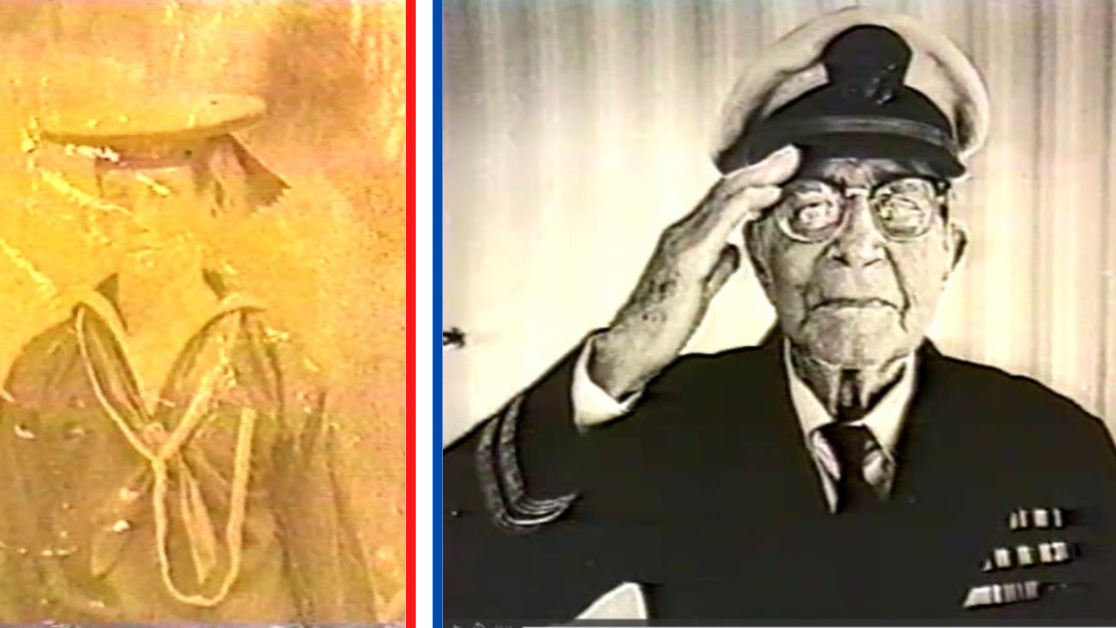The last member of the United Spanish War Veterans retired during WWII

Black and white photo of older man in US Navy uniform saluting.Contemporary photo of Lt. Nathan E. Cook in uniform. Taken from video. Nathan E. Cook Collection. Veterans History Project, AFC/2001/001/00567.
SUMMARY
It might seem odd for a sailor to retire in the middle of the biggest war the world had ever seen, but Nathan Cook was pushing 60 years old in 1942. World War II wasn’t the first war he’d fought during his time in the U.S. Navy. It wasn’t even his first World War. Cook had been in the Navy for more than 40 years, and it was time to go.
When asked how he felt after four decades of service, he responded in the typical fashion of a sailor as salty as he was: it sure beat working on a farm in Missouri. When he joined the Navy, the United States was still dealing with the aftermath of the Spanish-American War. He might have been too young to fight in that war, but he would soon see service in the Philippines – and beyond.
Although the Navy Nathan Cook joined around 125 years ago is literally separated from us by many lifetimes, it’s a testament to the cost of war that the Department of Veterans Affairs is still paying benefits to the widows and children of the Spanish-American War veterans. The war with Spain lasted less than a year, but the fighting in the newly-acquired U.S. possessions, especially the Philippines, continued.
In 1901, Cook was working in a meat packing facility in Kansas City when he dropped everything and lied about his age so he could enlist in the U.S. Navy. He was 15 years old. His first assignment was a Civil War-era steamer, the USS Pensacola, where he first learned to be a sailor.
Among his earliest assignments was America’s first coalition war: the Boxer Rebellion in China. An uprising of Chinese anti-foreign nationals saw the destruction of foreign property and the slaughter of Christian missionaries and their converts. Eight nations, including the United States, Austria-Hungary, Russia, Germany, Japan, Italy, Britain and France, moved troops to protect their embassies and holdings in China.
When the Imperial court turned on the eight-nation alliance and joined the Boxers, the 20,000 foreign troops defeated the Imperial Army and marched on China’s capital. By September 1901, the Boxers were beaten, the alliance occupied Zhili province, and rebels were being hunted across China. Cook’s time in the Pacific Ocean didn’t end in China, however.
The U.S. was in the middle of fighting a rebellion in the newly-annexed territory of the Philippines at the time, and young Cook was sent there with the Navy to help bring that war to its final conclusion. From there, Cook would serve aboard ships headed to Mexico to quell a series of ever-growing border clashes.
In 1913, a coup in Mexico installed Victoriano Huerta as president. Initially seen as pro-American, President Woodrow Wilson withdrew recognition of Huerta as his administration became increasingly dictatorial. After an incident in Tampico, Mexico saw nine American sailors arrested, President Wilson ordered the occupation of Veracruz. Chief Petty Officer Nathan Cook was aboard the battleship USS Florida.
When the U.S. entered World War I three years later, Cook was given a temporary commission as a lieutenant, first commanding a submarine chaser and later, a seagoing tug. During the Great War, Lt. Cook boasted three U-boat kills. When the war ended, he reverted back to his normal rating of Chief Boatswain.
When the Japanese attacked Pearl Harbor in 1941, Cook was still serving, at the time he was in the Caribbean and in Panama. He did not serve through the end of the war, however. He had served for 44 years, and he retired at the rank of lieutenant, a gift from the Navy for his World War I service. As a veteran, he would join the United Spanish War Veterans, which included those who served in the Philippines.
Lt. Nathan Cook would die in 1992, at the age of 106. At the time, he was the nation’s oldest living veteran, one who watched the U.S. grow from a small republic to a mighty overseas empire.
SHARE
